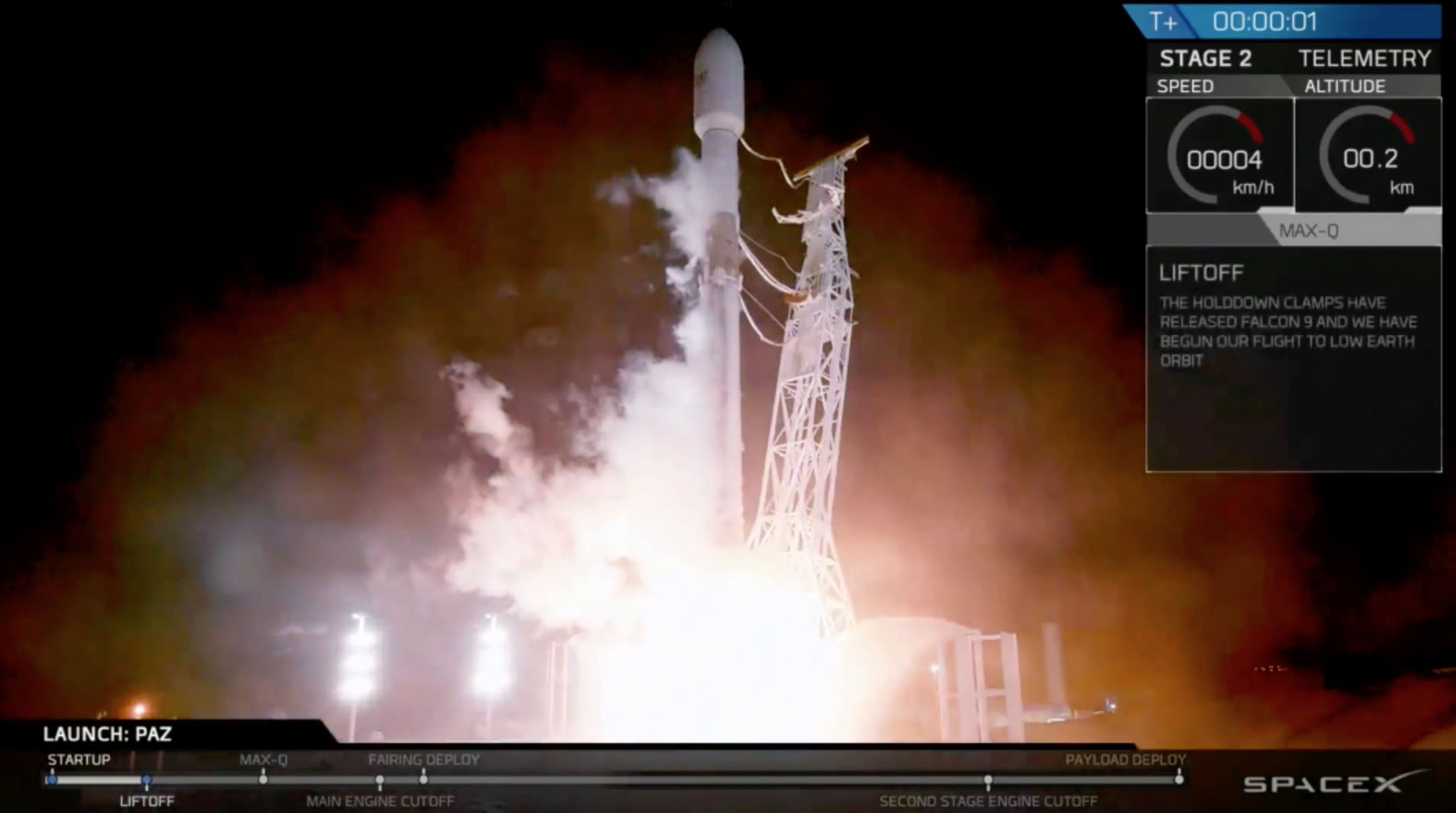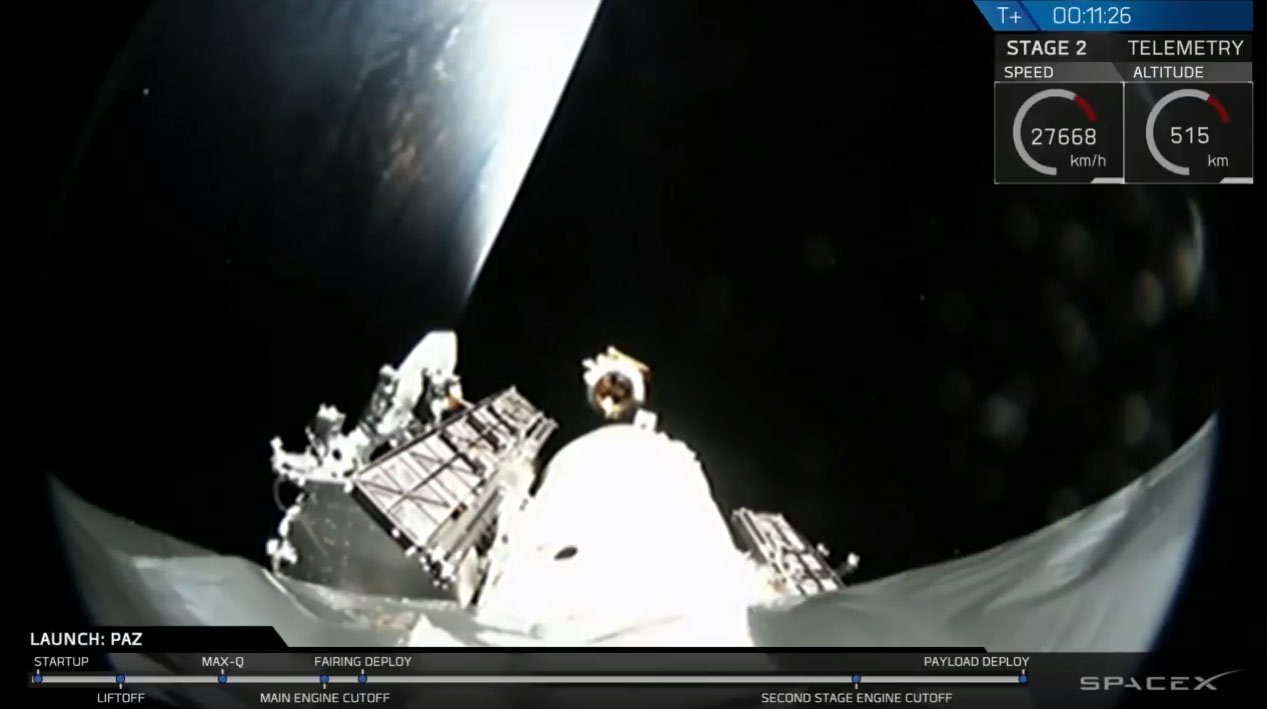SpaceX Launches 1st Test Satellites for Starlink Internet Constellation Along with Spain's Paz
A SpaceX Falcon 9 rocket with a pre-flown first stage successfully delivered to orbit today (Feb. 22) the first two prototypes for the company's huge Starlink satellite-internet constellation, along with a Spanish Earth-observing spacecraft.
The two-stage Falcon 9 lifted off from California's Vandenberg Air Force Base today at 9:17 a.m. EST (1417 GMT; 6:17 a.m. local California time) and successfully delivered its main payload, the Paz radar-imaging satellite, into its intended orbit. In a first, SpaceX also attempted to recover the protective nose-cone-like payload fairing in the Pacific Ocean with a net-carrying boat called Mr. Steven.
The launch kicked off the second space trip for the rocket's first stage, which also helped loft a Taiwanese Earth-observing satellite in August 2017. Last year, the first stage came back to Earth for a pinpoint landing on a SpaceX "drone ship" in the Pacific Ocean. But there was no repeat performance: SpaceX did not try to recover the booster during today's mission. [In Photos: SpaceX's Double Rocket Launches and Landings of October 2017]
The main goal today was getting the Paz satellite aloft for Spanish operator Hisdesat. If all goes according to plan, Paz will observe Earth in radar wavelengths from a 319-mile-high (514 kilometers) perch in quasi-polar orbit, gathering data for the Spanish government and other customers over the course of a mission lasting at least 5.5 years.

Paz "will be able to generate images with up to 25-[centimeter, or 10 inches] resolution, day and night and regardless of the meteorological conditions," SpaceX representatives wrote in a mission press kit.
The two SpaceX satellite-internet prototypes, known as Microsat-2a and Microsat-2b, rode along today as secondary payloads.
"These are meant to gather data in advance of deploying and operating a satellite constellation that will provide internet service," Tom Praderio, a SpaceX firmware engineer, said during live launch commentary. "Even if these satellites work as planned, we still have considerable technical work ahead of us to design and deploy a low-Earth satellite constellation."
Get the Space.com Newsletter
Breaking space news, the latest updates on rocket launches, skywatching events and more!

The two experimental craft will help get SpaceX's Starlink satellite-internet constellation off the ground. If everything works out, this meganetwork, which company founder and CEO Elon Musk first announced in 2015, will eventually consist of thousands of satellites. Together, these spacecraft will provide low-cost internet to people around the world, with services beginning in 2020, on at least a limited basis, SpaceX has said.
"This system, if successful, would provide people in low to moderate population densities around the world with affordable high-speed internet access, including many who have never had internet access before," Praderio said.
SpaceX hasn't said much about Starlink publicly; indeed, the company didn't even announce the presence of Microsat-2a and Microsat-2b on today's mission until yesterday (Feb. 21), when Musk tweeted about the duo. The spacecraft are mentioned in documents SpaceX filed with the Federal Communications Commission (FCC), however.
On Wednesday (Feb. 21), Musk did reveal on Twitter that the name for the Starlink satellites was inspired by the romantic novel "The Fault in Our Stars," by John Green.
"If anyone is curious, the name was inspired by The Fault in Our Stars," Musk wrote.
SpaceX isn't the only company with satellite-internet dreams. The FCC has already approved such projects being developed by OneWeb, Space Norway and Telesat. The FCC hasn't officially green-lit Starlink yet, but commission Chairman Ajit Pai recently endorsed the project and said he had urged the other four commissioners to do so as well.
Musk has said he plans to funnel the profits from Starlink into SpaceX's overarching goal: helping to establish a human settlement on Mars. The company is developing a huge new rocket-spaceship combo called the BFR for this purpose, aiming to use that craft to get a million-person Red Planet city up and running in the next 50 to 100 years.
Developing fully and rapidly reusable rockets and spacecraft is key to achieving Mars settlement and other ambitious spaceflight goals, Musk and others have stressed.
Today's launch further showcased SpaceX's progress on that path: This liftoff was the ninth involving a used Falcon 9 first stage. The company has successfully landed and recovered 23 such boosters, two of them during the maiden launch of SpaceX's huge Falcon Heavy rocket on Feb. 6.
SpaceX also tried to recover the clamshell-like payload fairing that protects the Paz and Starlink demonstration satellites during their ascent into space. After the fairing separated from the Falcon 9's second stage, it fell back to Earth and deployed a parafoil to slow its fall to the Pacific Ocean. SpaceX has built a fairing recovery boat, called Mr. Steven, which is equipped with a huge net held in place by giant metal arms to catch Falcon 9 payload fairings.
Musk announced on Twitter that the parafoil deployment occurred.
"Made it back from space and fairing parafoil just deployed," Musk wrote on Twitter. "Now trying to catch it."
Earlier, he shared a photo of the Mr. Steven boat on Instagram.
"Going to try to catch the giant fairing (nosecone) of Falcon 9 as it falls back from space at about eight times the speed of sound," Musk wrote on Instagram. "It has onboard thrusters and a guidance system to bring it through the atmosphere intact, then releases a parafoil and our ship, named Mr. Steven, with basically a giant catcher's mitt welded on, tries to catch it."
Ultimately, SpaceX was unable to catch the payload fairing with the net on Mr. Steven, but it was close, according to Musk.
"Missed by a few hundred meters, but fairing landed intact in water," Musk wrote on Twitter. "Should be able to catch it with slightly bigger shutes to slow down descent."
This morning's liftoff was originally scheduled to take place last Sunday (Feb. 18), but SpaceX pushed things back to accommodate final checks of the Falcon 9's payload fairing, the nose cone that protects satellites during launch. Another launch attempt yesterday was foiled by high winds.
Editor's note: This story was updated at 10:26 a.m. ET to include the results of SpaceX's attempt to recover the Falcon 9 payload fairing.
Follow Mike Wall on Twitter @michaeldwall and Google+. Follow us @Spacedotcom, Facebook or Google+. Originally published on Space.com.
Join our Space Forums to keep talking space on the latest missions, night sky and more! And if you have a news tip, correction or comment, let us know at: community@space.com.

Michael Wall is a Senior Space Writer with Space.com and joined the team in 2010. He primarily covers exoplanets, spaceflight and military space, but has been known to dabble in the space art beat. His book about the search for alien life, "Out There," was published on Nov. 13, 2018. Before becoming a science writer, Michael worked as a herpetologist and wildlife biologist. He has a Ph.D. in evolutionary biology from the University of Sydney, Australia, a bachelor's degree from the University of Arizona, and a graduate certificate in science writing from the University of California, Santa Cruz. To find out what his latest project is, you can follow Michael on Twitter.









